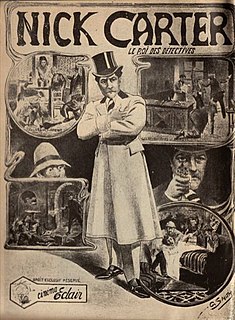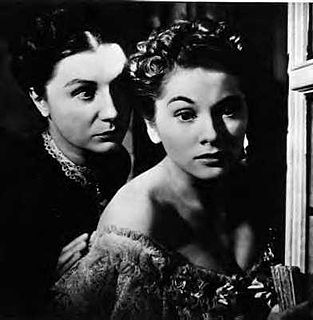
Crime fiction, detective story, murder mystery, mystery novel, and police novel are terms used to describe narratives that centre on criminal acts and especially on the investigation, either by an amateur or a professional detective, of a crime, often a murder. It is usually distinguished from mainstream fiction and other genres such as historical fiction or science fiction, but the boundaries are indistinct. Crime fiction has multiple subgenres, including detective fiction, courtroom drama, hard-boiled fiction, and legal thrillers. Most crime drama focuses on crime investigation and does not feature the courtroom. Suspense and mystery are key elements that are nearly ubiquitous to the genre.

Mystery is a fiction genre where the nature of an event, usually a murder or other crime, remains mysterious until the end of the story. Often within a closed circle of suspects, each suspect is usually provided with a credible motive and a reasonable opportunity for committing the crime. The central character is often a detective, who eventually solves the mystery by logical deduction from facts presented to the reader. Some mystery books are non-fiction. Mystery fiction can be detective stories in which the emphasis is on the puzzle or suspense element and its logical solution such as a whodunit. Mystery fiction can be contrasted with hardboiled detective stories, which focus on action and gritty realism.

In Canadian folklore, the Ogopogo is a lake monster said to inhabit Okanagan Lake in British Columbia, Canada. Some scholars have charted the entity's development from First Nations folklore and widespread water monster folklore motifs. The Ogopogo now plays a role in the commercial symbolism and media representation of the region.
Psychological horror is a subgenre of horror and psychological fiction with a particular focus on mental, emotional, and psychological states to frighten, disturb, or unsettle its audience. The subgenre frequently overlaps with the related subgenre of psychological thriller, and often uses mystery elements and characters with unstable, unreliable, or disturbed psychological states to enhance the suspense, drama, action, and paranoia of the setting and plot and to provide an overall unpleasant, unsettling, or distressing atmosphere.

A mystery film is a genre of film that revolves around the solution of a problem or a crime. It focuses on the efforts of the detective, private investigator or amateur sleuth to solve the mysterious circumstances of an issue by means of clues, investigation, and clever deduction.

Hayford Peirce was an American writer of science fiction, mysteries, and spy thrillers. He attended Phillips Exeter Academy and received his BA from Harvard College. He wrote numerous short stories for the science-fiction magazines Analog, Galaxy, and Omni, as well as mystery shorts for Alfred Hitchcock's Mystery Magazine and Ellery Queen's Mystery Magazine. Most of his stories are light-hearted and satiric in tone, with elements of black humor and occasional surprising grimness.

This is a list of lists of horror films. Often there may be considerable overlap particularly between horror and other genres.
Phoebe Sarah Nicholls is an English film, television, and stage actress. She is known for her roles as Cordelia Flyte in Brideshead Revisited and as the mother of John Merrick in The Elephant Man.
Psychological thriller is a genre combining the thriller and psychological fiction genres. It is commonly used to describe literature or films that deal with psychological narratives in a thriller or thrilling setting.

Michel de Grammont was a French privateer. He was born in Paris, Kingdom of France and was lost at sea in the north-east Caribbean, April 1686. His privateer career lasted from around 1670 to 1686 during which he commanded the flagship Hardi. He primarily attacked Spanish holdings in Maracaibo, Gibraltar, Trujillo, La Guaira, Puerto Cabello, Cumana and Veracruz.
The Reckoning may refer to:

Monster is a psychological thriller and murder mystery novel by Jonathan Kellerman. It is the 14th novel in the Alex Delaware series.

Horror comics are comic books, graphic novels, black-and-white comics magazines, and manga focusing on horror fiction. In the US market, horror comic books reached a peak in the late 1940s through the mid-1950s, when concern over content and the imposition of the self-censorship Comics Code Authority contributed to the demise of many titles and the toning down of others. Black-and-white horror-comics magazines, which did not fall under the Code, flourished from the mid-1960s through the early 1980s from a variety of publishers. Mainstream American color comic books experienced a horror resurgence in the 1970s, following a loosening of the Code. While the genre has had greater and lesser periods of popularity, it occupies a firm niche in comics as of the 2010s.

Seven Keys is a 1962 British crime thriller directed by Pat Jackson and starring Alan Dobie.

The House of the Arrow is a 1953 British mystery film directed by Michael Anderson and starring Oskar Homolka, Robert Urquhart and Yvonne Furneaux. It is the fourth film version of the 1924 novel The House of the Arrow by A. E. W. Mason, featuring his French detective Inspector Hanaud.

Thriller film, also known as suspense film or suspense thriller, is a broad film genre that evokes excitement and suspense in the audience. The suspense element found in most films' plots is particularly exploited by the filmmaker in this genre. Tension is created by delaying what the audience sees as inevitable, and is built through situations that are menacing or where escape seems impossible.

Fantastic Novels was an American science fiction and fantasy pulp magazine published by the Munsey Company of New York from 1940 to 1941, and again by Popular Publications, also of New York, from 1948 to 1951. It was a companion to Famous Fantastic Mysteries. Like that magazine, it mostly reprinted science fiction and fantasy classics from earlier decades, such as novels by A. Merritt, George Allan England, and Victor Rousseau, though it occasionally published reprints of more recent work, such as Earth's Last Citadel, by Henry Kuttner and C. L. Moore.

"Man of Mystery" is a song by the Shadows, released as a single in November 1960. It peaked at number 5 on the UK Singles Chart.

Jack O'Lantern is a 1929 mystery thriller novel by the British writer George Goodchild. Goodchild was a prolific writer of thrillers in the style of Edgar Wallace and Sydney Horler. It was published in the United States the following year by The Mystery League. Another of his novels The Monster of Grammont was published by them in 1931.















